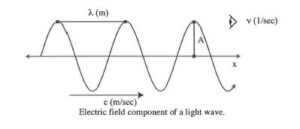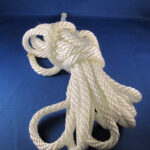Rope-a-dope: Properties of Waves
Subject: Physics
Grade Level(s): Grade 8, High School, Grade 7
Topic: Waves
Big Idea(s): For this experiment, you will work in groups of two or three. Your goals are to:
- Make standing waves with 0 to 3 nodes.
- Characterize each standing wave.
- Develop a qualitative relationship between frequency and wavelength.
What you need:
- Rope
- Measuring Tape
- Timer
Grouping:
Vocabulary Words:
Time Needed:
Summary:
For this experiment, you will work in groups of two or three. Your goals are to:
- Make standing waves with 0 to 3 nodes.
- Characterize each standing wave.
- Develop a qualitative relationship between frequency and wavelength.
Learning Goals / Objectives:
- Waves can be characterized by wavelength and frequency.
- Wavelength and frequency are inversely related.
- Standing waves can be used as models to describe light waves.
Background
Light can be described as an electromagnetic wave (see figure below). Light waves can be characterized by four properties:
- Wavelength, λ (lamda). This is the length of one full cycle of the wave. Typically wavelength is measure as the distance between two maxima. Wavelength has distance units like m or nm.
- Speed, c. In any given medium, light travels at a constant speed. The speed of light in vacuum is 3.0 x 108 m/sec.
- Frequency, v (nu). The frequency of light is the number of full wave cycles that pass through a particular point per second. Frequency has units of 1/sec or Hz.
- Amplitude, A. Classically, amplitude is proportional to the total energy of the light. Nodes are places where the amplitude of a wave is zero.
From their definitions alone, it should come as no surprise that wavelength, speed and frequency are intimately interrelated:
Key to these relationships is that wavelength and frequency are inversely related. That is: Long wavelengths have Small frequencies and vise versa.
Anticipatory Set:
1. How can we characterize a wave?
2. How do frequency and wavelength relate to each other?
Instructions / Activities:
- Fasten one end of your rope to a fixed object (a door knob or table leg may work). Get a firm grip on the other end of the rope.
- Get a feel for making standing waves on the rope.
- Move the rope up and down and try to get a standing wave with no nodes in the middle. You may find that turning the rope like a jump rope works best.
- When you have a fairly stable standing wave with no nodes, try to get one, two and three nodes. Warning: three will be a workout.
- Characterize each standing wave. This is a two or three person job. One person will produce a standing wave (the turner) and the others will make measurements (the observers) to fill in the table below.
- To estimate the wavelength, either measure the length of one full cycle or measure the entire length of the standing wave and divide by the number of cycles present. Note: the standing wave with no nodes is only half of a full cycle.
- To estimate the frequency, the observes will count the number of times the turners hand goes up and down in 30 sec. The number of “up and downs” is equal to the number of cycles.
V = (number of cycles)/time
- Sketch each standing wave. Include labels and approximate distances.
Assessment:
Teacher’s Discretion
Wrap-up / Closure:
- How are frequency and wavelength related?
- What did you notice as the number of nodes increased? Can you explain your observations?
- What tips would you give a student attempting this exercise?
These materials are contained in a kit in our Library!
Tags: Grade 7, Grade 8, High School
Categories: Physics



